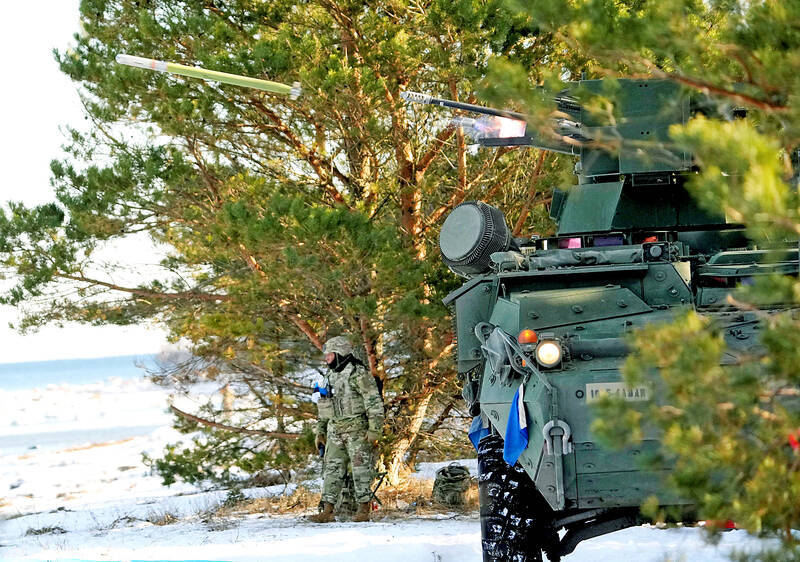A batch of FIM-92 Stinger missiles arrived overnight on Thursday, the Chinese-language United Daily News reported yesterday, citing an unnamed source.
The arms shipment delivered in a Boeing 747 cargo plane at Taiwan Taoyuan International Airport has been received by the Ministry of the National Defense, the newspaper reported.
It is part of a US$500 million aid package to Taiwan utilizing the US’ presidential drawdown authority, which draws from US stocks of weaponry and has been used to expedite weapons deliveries to Ukraine, the report said.

Photo: REUTERS
The air defense weapons are handheld portable variants of the Stinger missile system.
The package is believed to include weapons systems earmarked for Taiwan, but whose delivery had been delayed due to the Russia-Ukraine war and supply chain issues related to the COVID-19 pandemic.
The armed forces already operate variants of the missile, including the Dual Mount Stinger (DMS), the Humvee-mounted Avenger weapons system and an air-launched version adapted for Apache attack helicopters.
Stingers are light, mobile, fire-and-forget air defense weapons that enable the operator to seek cover, relocate or engage a new target immediately after firing, which increases efficiency. They can also be used as short-range weapons against aircraft flying at low altitudes.
The US authorized the transfer of Stinger missile systems in 1996. No further transfers were made after 2000 out of concern that the weapons possess an offensive potential.
On Tuesday last week, US Secretary of Defense Lloyd Austin told the US Congress that a substantial military aid package would be delivered to Taiwan.
Minister of National Defense Chiu Kuo-cheng (邱國正) confirmed that the US had informed Taipei of the package ahead of its public announcement.
Commenting on condition of anonymity, a US defense official said that US President Joe Biden used special emergency presidential powers to authorize the package and ensure that backlogged arms would be delivered to bolster Taiwan’s defenses.
No further comments about the implementation details and items in the package could be made, they said.
Yesterday, Institute for National Defense and Security Research analyst Shu Hsiao-huang (舒孝煌) said that the backbone of the nation’s air defenses is comprised of US-made Patriot and domestically developed Tien Kung missiles, but the nation lacks weapons that are effective against low-flying aircraft.
Portable handheld Stinger air defense missiles would be effective against helicopters and drones launched from Chinese People’s Liberation Army amphibious assault ships, he said.
Recent simulations conducted by US think tanks have underscored the importance of having adequate stockpiles of ammunition in deterrence and warfare, he said.
Modern warfare is highly intensive in the use of ammunition and equipment, and Taiwan would not be able to resupply if it is subjected to a naval blockade, Shu said.
The reported inclusion of Stinger missiles and anti-armor weapons such as TOWs and Javelins in upcoming packages suggests that the US is prioritizing territorial defense over long-range strikes or decisive battles at the beachhead, retired air force lieutenant general Chang Yan-ting (張延廷) said.
Ukraine defends its air space from Russia by utilizing air defense missiles, including Stingers, which precludes the invaders from deploying mass airstrikes, he said.
Additional reporting by Wu Su-wei

The combined effect of the monsoon, the outer rim of Typhoon Fengshen and a low-pressure system is expected to bring significant rainfall this week to various parts of the nation, the Central Weather Administration (CWA) said. The heaviest rain is expected to occur today and tomorrow, with torrential rain expected in Keelung’s north coast, Yilan and the mountainous regions of Taipei and New Taipei City, the CWA said. Rivers could rise rapidly, and residents should stay away from riverbanks and avoid going to the mountains or engaging in water activities, it said. Scattered showers are expected today in central and

People can preregister to receive their NT$10,000 (US$325) cash distributed from the central government on Nov. 5 after President William Lai (賴清德) yesterday signed the Special Budget for Strengthening Economic, Social and National Security Resilience, the Executive Yuan told a news conference last night. The special budget, passed by the Legislative Yuan on Friday last week with a cash handout budget of NT$236 billion, was officially submitted to the Executive Yuan and the Presidential Office yesterday afternoon. People can register through the official Web site at https://10000.gov.tw to have the funds deposited into their bank accounts, withdraw the funds at automated teller

COOPERATION: Taiwan is aligning closely with US strategic objectives on various matters, including China’s rare earths restrictions, the Ministry of Foreign Affairs said Taiwan could deal with China’s tightened export controls on rare earth metals by turning to “urban mining,” a researcher said yesterday. Rare earth metals, which are used in semiconductors and other electronic components, could be recovered from industrial or electronic waste to reduce reliance on imports, National Cheng Kung University Department of Resources Engineering professor Lee Cheng-han (李政翰) said. Despite their name, rare earth elements are not actually rare — their abundance in the Earth’s crust is relatively high, but they are dispersed, making extraction and refining energy-intensive and environmentally damaging, he said, adding that many countries have opted to

PEACE AND STABILITY: Maintaining the cross-strait ‘status quo’ has long been the government’s position, the Ministry of Foreign Affairs said Taiwan is committed to maintaining the cross-strait “status quo” and seeks no escalation of tensions, the Ministry of Foreign Affairs (MOFA) said yesterday, rebutting a Time magazine opinion piece that described President William Lai (賴清德) as a “reckless leader.” The article, titled “The US Must Beware of Taiwan’s Reckless Leader,” was written by Lyle Goldstein, director of the Asia Program at the Washington-based Defense Priorities think tank. Goldstein wrote that Taiwan is “the world’s most dangerous flashpoint” amid ongoing conflicts in the Middle East and Russia’s invasion of Ukraine. He said that the situation in the Taiwan Strait has become less stable